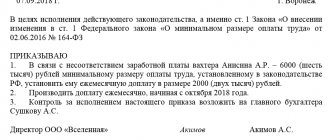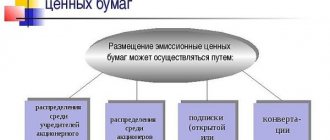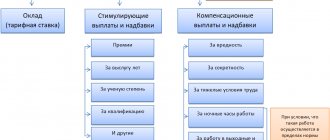Basic moments
In case of production necessity, the employer has the right to involve the employee in additional work. The Labor Code of the Russian Federation provides three ways for an employee to perform additional work without exemption from the main one:
- combination of positions;
- increase in the volume of work;
- fulfilling the duties of a temporarily absent colleague.
Additional duties are performed under the following conditions:
- without interrupting your main job;
- during the established working hours (Part 1, Article 60.2 of the Labor Code of the Russian Federation).
To issue an order to assign additional work to an employee under Art. 60.2 of the Labor Code of the Russian Federation, consider several rules:
- the employee provided written consent;
- the activity relates to a different or similar position;
- labor is paid additionally.
The employee’s consent can be formalized as follows:
But first, the employee’s immediate supervisor sends a notice to the director of the enterprise about the situation that has arisen and the need to temporarily transfer responsibilities to one of the employees.
If the employee agrees to additional work, not only a sample order to increase the volume of work for the same position is drawn up, but also an additional agreement to his employment contract. It states:
- what needs to be done and for what period;
- amount of surcharge;
- the period during which a citizen works under new conditions.
Based on the concluded agreement, using a sample order for additional payment for additional work, the employer issues an order for the temporary performance of additional duties. The employee must be familiarized with the document and signed.
We suggest taking our sample order for additional payment for an increase in the amount of work as a basis and modifying it to suit your needs.
Combination as a type of additional work and its difference from part-time work
| Combination (Article 60.2 of the Labor Code of the Russian Federation) | Part-time work (Articles 282, 284 of the Labor Code of the Russian Federation) |
| FORM | |
| Written consent of the employee, order; it is necessary to conclude an agreement between the parties. | Employment contract. The employment contract must indicate that the job is a part-time job. |
| WORK TIME | |
| Performing work during the established duration of the working day (shift) along with the work specified in the employment contract. | Perform work in free time from main work, no more than 4 hours a day. On days when the employee is free from performing work duties at his main place of work, he can work part-time full time (shift). |
| EMPLOYER | |
| The work is performed for the same employer. | Part-time work can be performed by an employee both at the place of his main job (note internal part-time work) and with other employers (note external part-time work). |
| TERMINATION OF OPERATION | |
| The employee has the right to refuse to perform additional work ahead of schedule, and the employer has the right to cancel the order to perform it ahead of schedule, notifying the other party in writing no later than three working days in advance. | Termination of an employment contract is possible on the grounds provided for by the Labor Code of the Russian Federation (Chapter 13 of the Labor Code of the Russian Federation), as well as in accordance with Art. 288 of the Labor Code of the Russian Federation in cases where an employment contract concluded for an indefinite period with a person working part-time can be terminated if an employee is hired for whom this work will be the main one, about which the employer warns the specified person in writing at least than two weeks before the termination of the employment contract. |
How does the surcharge work?
According to Part 2 of Art. 151 of the Labor Code of the Russian Federation, the amount of additional payment for additional work is determined by agreement of the parties. When determining the amount, the employer must take into account:
- content and (or) scope of duties performed (Article 151 of the Labor Code of the Russian Federation);
- qualifications of the employee, complexity and conditions of the work performed, quantity and quality of labor expended (Article 129, Article 132 of the Labor Code of the Russian Federation);
- the employer’s obligation to provide equal pay for work of equal value (paragraph 6, part 2, article 22 of the Labor Code of the Russian Federation).
The Labor Code of the Russian Federation does not define either the minimum or maximum amount, but as an example of additional payment for additional work, use:
- the agreed amount of money;
- interest on the employee’s salary / tariff rate.
All payments are made officially with the execution of the relevant documents. Any discrimination in establishing and changing wage conditions is prohibited.
Cases of surcharge using specific examples
Example 1. Ivanova combines her main position as a secretary with the additional position of a cashier. The Regulations on Remuneration establishes that the additional payment for combining positions, if the salary (tariff rate) for any of the positions is not higher than 10 thousand rubles, will be 50% of the salary (tariff rate) for the main position. For August 2021, Ivanova was accrued the following monetary amounts for her main position:
- salary - 8000 rubles;
- additional payment for overtime work - 1000 rubles.
So, Ivanova’s salary for August with an additional payment for combining positions is 13,000 rubles. (8000 rub. + 8000 rub. x 50% + 1000 rub.).
The following example is about expanding the service area. So, the salary of the waitress Kazankova is 10,000 rubles. Due to the dismissal of several employees, she needs to expand the service area, that is, serve not 8 tables, but 14. The management, together with Kazankova, decided that the amount of her additional payment for each month would be proportional to the number of tables added to the service. Guided by a written agreement between the employee and the employer, her monthly additional payment for expanding the service area is 7,500 rubles. (RUB 10,000: 8 tables x (14 tables - 8 tables)). Example 3. The head of the legal department, Klimenko, went on vacation. The performance of his duties was temporarily assigned to senior lawyer Komanich. The agreement between the employee and management provides that additional payment for performing the duties of a temporarily absent employee is made in the amount of the difference between the salary of the head of the legal department and the salary of a senior lawyer in proportion to the time the duties are performed. The salary of the head of the legal department Klimenko is 18,000 rubles, and the senior lawyer’s salary is 10,000 rubles. So, the monthly additional payment will be 8,000 rubles. (RUR 18,000 – RUR 10,000). A senior lawyer has a 5-day work week and 2 days off (Saturday and Sunday). In September 2010, Komanich temporarily performed part of the duties of the head of the legal department without being released from his main job for 10 working days. Since there are 22 working days in September, the amount of additional payment for a temporarily absent person will be 3,636.36 rubles. (RUR 8,000: 22 days x 10 days).
Author of the article
Increasing the volume of work without additional payment
The job descriptions of some employees state that during the absence of another employee with similar job responsibilities from the workplace, they perform the functions of absent colleagues. The specified provisions of job descriptions are an integral part of contracts, and no additional payment is due for the performance of additional duties. An indication of this is contained in the Letter of the Ministry of Health and Social Development of Russia dated March 12, 2012 No. 22-2-897. Therefore, if, according to the job description and employment contract, one employee is not authorized to completely replace another, additional payment is possible.
How to write a statement and memo
The application should be addressed to the head of the organization. It is necessary to reflect the following points:
- Request to expand the service area or transfer additional functions.
- The reason why this needs to be done. You can identify both circumstances that have arisen in the organization (for example, a colleague going on maternity leave) and your own capabilities.
- The period within which the employee agrees to perform extra work.
- The amount of additional payment he wants to receive for it.
Having received such a document and agreed to the terms, the manager puts the appropriate mark at the bottom with his signature.
In a memo, the head of the unit needs to state the same thing, only on his own behalf. There is no need to agree on it. A positive response will be an order from the manager to entrust these functions to that same employee.
Abolition of additional labor
The increase in the volume of work ceases upon expiration of the period for which it was agreed. In this case, the director of the enterprise issues an order to stop the accrual and payment of additional payments by the accounting department.
Both the employee and the company have the right to refuse to increase the amount of work ahead of schedule. For this purpose, three working days in advance, one party warns the other in writing of its desire. This is either a statement from the employee or a notification from the employer, which is drawn up in free form. The employee's notice must be read and signed.
The fact of termination of the increased volume of work must be recorded by order. It should indicate the termination date. The employee is presented with the order against his signature.
Registration of additional work (Article 60.2, 151 of the Labor Code of the Russian Federation)
Establishment of additional work:
A written statement from the employee, in which the employee agrees to:
- the period during which the employee will perform additional work,
- content and scope of additional work.
An order from the employer to assign additional work to the employee, indicating the period during which the employee will perform additional work, the content and volume of additional work.
Agreement of the parties indicating the amount of additional payment, taking into account the content and (or) volume of additional work, and other necessary conditions.
Attention: information about additional work is not entered into the employee’s work book!
Cancel additional work:
A written statement from the employee refusing to perform additional work, submitted to the employer no later than 3 working days before the termination of additional work.
An employer's order to remove additional work from an employee, presented to the employee for signing no later than three days before the termination of additional work.
Agreement of the parties to terminate the agreement to establish additional work.
Answers to frequently asked questions
Question No. 1: The employer assigned his employee to perform one more duties (new job). The parties reached certain agreements, but there was no formalization. Can an employee, under these circumstances, demand payment for combining?
This is important to know: Guardianship of a disabled person of group 1: how to register, what benefits are entitled
Maybe, and by all available legal means. But if the case goes to court, then the person in question will need to prove that he actually combined work, provide documentary evidence, etc. In the absence of any evidence, it will be very difficult for the employee to achieve a positive decision.
Question No. 2: Are there additional days off for combined work? And are they paid?
No. The Labor Code of the Russian Federation does not provide for additional rest in such cases. But when calculating vacation pay for the main paid vacation, an additional payment for combined work is included in the calculation base.
Combination restrictions
The code does not contain information about restrictions on combining positions. Almost any employee in an organization can be assigned this type of work. There are two important factors to consider:
Any combination must be included in working hours, and not in excess of its norm.
It is advisable to combine positions of similar professions or employee qualifications. This is due to more competent performance of duties without wasting time on training.
However, we should not forget about the privileged category of citizens: pregnant women, disabled people, minor employees and mothers with children under three years of age. Although the law does not prohibit them from increasing the load, it is better to insure against unpleasant consequences.
This is important to know: Car purchase and sale agreement: how to draw up and fill out correctly, form and sample 2021
To do this, you can discuss all working conditions, assess their applicability to these individuals and sign all the necessary documents.
Management response and response
The manager's decision will be addressed to the appropriate service of the enterprise depending on his decision , for example:
- To the Personnel Department and the Remuneration Department in case of a positive decision. These services will prepare an order and issue an additional payment upon completion of the replacement period.
- Return to the department that issued the Service Note in case of refusal or other decision.
- Delegate this issue to another employee, for example, a deputy.
We talked about how to correctly write a response to a memo here.
A correctly composed text of the memo is the key to a successful resolution of your request or proposal. Read about how to correctly write this document for dismissal, write-off of material assets, fixed assets, promotion of an employee, issuance of funds, time off, purchase of goods, employment, business trips, disruptions in work on our Internet portal.








